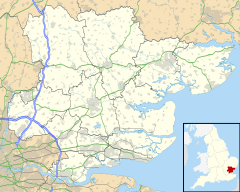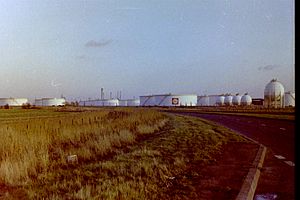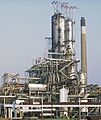Shell Haven facts for kids
Quick facts for kids Shell Haven |
|
|---|---|
 |
|
| OS grid reference | TQ728815 |
| Unitary authority | |
| Ceremonial county | |
| Region | |
| Country | England |
| Sovereign state | United Kingdom |
| Post town | STANFORD-LE-HOPE |
| Postcode district | SS17 |
| Dialling code | 01375 |
| Police | Essex |
| Fire | Essex |
| Ambulance | East of England |
| EU Parliament | East of England |
| UK Parliament |
|
Shell Haven was once a busy port and later a large oil refinery located on the north bank of the Thames Estuary in Thurrock, Essex, England. The oil refinery stopped working in 1999. After that, a company called DP World bought the land. They planned to build a new, big shipping port there called London Gateway. This new port was approved in 2007. A nearby oil refinery, Coryton Refinery, kept working until 2012.
Contents
History of Shell Haven
Shell Haven has a long history. It appeared on a map of Essex in 1596. It was even mentioned in the famous diary of Samuel Pepys in 1667.
From Inlet to Industrial Hub
Historically, Shell Haven was an inlet on the River Thames. It was the mouth of Shell Haven Creek. This creek separated two marshy areas. Some records suggest the oil industry might have been linked to this area very early on. For example, an "Oil Mill Farm" was shown nearby in the early 1800s.
In the 1850s, a branch line for trains was built. It connected the main railway to a new port called Thames Haven. This port was right next to Shell Haven. However, Thames Haven didn't become very successful. Later, the Shell oil company arrived, and the name Shell Haven became well-known.
Explosives and Oil Storage
In 1895, a company that made ammunition, Kynochs, bought land near Shell Haven Creek. They built an explosives factory there, which opened in 1897. They even built a small village for their workers called Kynochtown. Kynochs also built a special railway, the Corringham Light Railway (CLR).
The Kynoch factory closed in 1919. Then, a coal company, Cory Brothers Ltd, took over the site and the railway. They built a place to store oil. Kynochtown was renamed Coryton. This oil storage area eventually became the Coryton Refinery. It continued to produce oil products for many years.
Shell's Oil Refinery
The Shell oil company, through a sales company called Asiatic Petroleum Company Ltd, started storing petroleum at Shell Haven in 1912. They could store up to 80,000 tonnes of oil in large tanks.
The actual refinery operations began in 1916. They had a plant that could separate crude oil. This plant first made fuel oil for the British Admiralty (the British Navy). Later, in 1919, it was changed to make bitumen, which is used for road surfaces. In 1925, they started making lubricating oils.
During World War 2, the oil refineries and storage tanks in this area were targets for air raids. This happened especially in September 1940, during the Battle of Britain.
Growing the Refinery
After the war, the refinery kept growing. In 1946, they started making high-quality Paraffin Wax. In 1947, a big expansion began on a much larger area west of the original refinery.
In 1948, Shell decided to build a new, large crude oil refinery. It would mainly process oil from Kuwait.
The new facilities included:
- A unit to separate crude oil, called CDU1. It could process 6,000 tonnes of Kuwait crude oil each day.
- A High Vacuum Unit (HVU) to process heavier oil parts.
- A Thermal Reformer to improve gasoline.
- A unit to treat gasoline.
- New steam boilers for power.
In 1950, some of these new units started working. Over the years, more units were added to make different valuable products from the oil. In 1956, a 'Platformer' was added to make better gasoline. Also, a unit to make chemicals for household detergents was built. A second crude oil separation unit was added in 1959.
By 1992, the refinery had grown even more. It could process 4.6 million tonnes of oil each year. It covered a huge area, about 800 hectares (2,000 acres). It had its own power plant and emergency services. It also had five jetties (docks) where very large oil tankers could unload. The refinery sent its products out by road, ship, and through the UK oil pipeline network.
Safety Challenges
Between 1970 and 1973, there were three major fires at the refinery.
Closure and New Beginnings
The Shell refinery at Shell Haven closed down in 1999. A special team helped to shut it down and take apart most of the refinery. Some parts, like the Bitumen Plant and some storage tanks, were left. Two large reactors from the Hydrocracker Unit were even moved to another Shell refinery in Germany in 2004, where they are still used today.
In 2006, the land was bought by DP World. This company is one of the biggest port operators in the world. In May 2007, DP World received permission to build a major new deep-water port on the site. This new port is called London Gateway. Besides the port, the plan also includes one of Europe's largest logistics parks. This park will help move goods to and from London and the rest of the UK.
In 2008, the government gave official permission for London Gateway to operate as a port. DP World plans to invest over £1.5 billion to develop the project over the next 10 to 15 years.
The Bitumen Unit, one of the last remaining parts of the old refinery, was also being taken apart in 2010. The site is now being cleaned up by a company called Hydrock to prepare it for the new port and industrial park.
Shell Haven Refinery in Film
The old Shell Haven Refinery was used as a filming location for the movie Quatermass 2.
How the Refinery Worked (Simplified)
The Shell Haven refinery was a complex place with many different units working together to turn crude oil into useful products.
Crude Oil Processing
Crude oil arrived at the jetties by large oil tankers. This oil was then pumped into huge storage tanks, each holding up to 100,000 tonnes. Before the oil went into the main processing unit, it passed through a "Desalter" unit. This unit washed out salt from the crude oil, which could damage the equipment.
The main unit was the Crude Distiller. Here, the crude oil was heated and separated into different parts based on their boiling points. These parts included heavy oils (like long residue and waxy distillate), and lighter products like butane, propane, kerosene, gas oil, and naphtha. Any waste gases, like methane, were sent to a special flare system.
High Vacuum Unit
After the first distillation, a High Vacuum Unit (HVU) processed the heavier parts of the oil. This unit used a vacuum to separate even more products, like short residue, waxy distillate, and blowing flux. The waxy distillate later became the main input for another important unit called the Hydrocracker.
Controlling the Refinery
Most of the refinery's operations were controlled from a Central Control Room, which was built in 1992. This room helped manage the different processing units and made communication easier. However, the large tank farm and the waterfront areas had their own separate control room.
The Flare System
The Flare System was a safety system designed to handle any extra gas produced by the refinery units. If too much gas was produced, or if pressure built up in the equipment, the gas would be sent to the flare system. This system had two tall flare stacks. Before the gas reached the stacks, it passed through special vessels that removed any liquid hydrocarbons. A compressor would try to send the gas back to be used as fuel in the refinery's furnaces. If the furnaces couldn't use all the gas, it would be safely burned at the top of the flare stacks. Steam was injected with the gas to help it burn cleanly.
Cooling Water System
Some parts of the refinery needed water to cool down the hot process streams. This water came from the River Thames. It passed through screens to remove debris before being pumped to the different units through underground pipes. Newer units often used "fin fan" cooling, which uses air instead of water. The Cooling Water Pumphouse also supplied water to a special pipeline called a firemain. This firemain ran around the refinery and had dedicated pumps to provide water in case of a fire.
Images for kids









